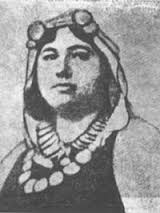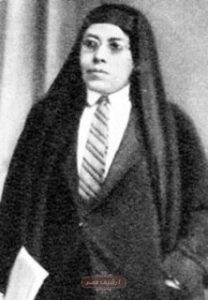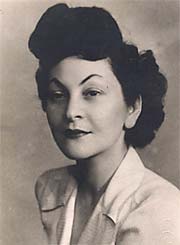In 1923 the Egyptian Feminist Union was established, becoming the first national feminist movement in Egypt. On the sixth of March 1923, 100 years ago, a number of Egyptian activists founded the union.
The union had various well-known women in leading positions, along with others who were inspired by the union to fight their struggles.
Malak Hifni Nasif
One of the first women to start the fight for gender equality in Egypt was Malak Hifni Nasif. Nasif was an Egyptian feminist who contributed to the intellectual and political discourse to grant Egyptian women their rights in the early 20th century.
She was born in 1886 to a middle-class family, to a lawyer father, Hifni Bey Nasif, who was a member of Muhammad Abduh’s party. Her father encouraged her to have a proper education, and to read Arabic poetry. As she grew up she started writing her own poetry in her free time.
Nasif graduated with the first girls’ section in the Abbas Primary School in 1901. She then continued her education at the Saniyyah Teacher Training College, graduating at the top of her class in 1903.
Nasif worked as a teacher for two years after her graduation, but was forced to quit when she married because the Egyptian forbid women to teach after marriage.
During her marriage, she moved with her husband to al-Fayyum where she began writing under the pseudonym Bahithat al-Badiya. This was where she found out that her husband was already married and had a child.
Her marriage struggle inspired her to start writing about feminism and to present “attempt to reform” the Egyptian future.
Nasif was one of the very few feminists who combined westernization with Islam and traditionalism, because she believed that a combination of the two would lead women forward in the right direction.
She wrote a lot about her opposition to polygamy and marriage in Egypt. She took action on her views by starting organizations and seeking political action.
Nasif founded the Union for the Education of Women, an emergency health service, and a nursing school for women inside her home. She also proposed a new policy for education, saying that it should include things like hygiene and economics, and that it should be available for all women of different backgrounds.
Nasif died of the flu in 1918 leaving behind a powerful legacy to be remembered for more than 100 years after her death.
Nabawiyya Musa
Nabawiyya Musa is another prominent Egyptian feminist and nationalist and one of the founding members of the Egyptian Feminist Union. Her career is often discussed alongside prominent feminists such as Malak Hifni Nasif and Huda Sharawi. Musa usually discussed education, health, and sexual exploitation of women.
She grew up in Alexandria and was from the Egyptian middle class. She was an educator and a prolific writer, writing articles such as “A Treatise on Girls’ Education” in 1902.
Musa was the first Egyptian woman to finish high school in 1907 and her writing reflect the period in the Egyptian history that her life spanned.
Musa believed that women would only have an opportunity to change the state if they were give independence and equal rights with men. She also believed wholeheartedly that the differences between men and women were nothing but a social construct and could easily be broken by time.
Through her promotion of women’s education she sought to end sexual violence against women. She maintained that giving women an equal status as men in both education and the workplace will make them less vulnerable and less prone to sexual assault.
In 1923, she alongside Huda Shaarawi cambe back to Egypt from a conference in Rome unveiled as a proclamation to Egyptian society.
She published her memoirs in columns in her woman’s magazine (Majallat Al-Fata) between 1938 and 1942, to be later published in a book under the title My History, by My Pen.
Musa died in 1951 at the age of 61.
Huda Shaarawi
Huda Shaarawi is one of the most prominent figures in Egyptian feminism and founder of the Egyptian Feminist Union in 1923.
Coming from the upper Egyptian city of Minya from the Shaarawi family, she educated at an early age along with her brothers. After her father’s death, she lived under the guardianship of her cousin, Ali Shaarawi, to marry him at the age of thirteen.
She participated in a women-led protest during the Egyptian Revolution of 1919 advocating for Egyptian independence from the British occupation. Her husband during that time was acting vice president for the Wafd political party, and then the Wafdist Women’s Central Committee, associated with Wafd, was founded in January of 1920.
At that time, Egyptian women were confined to the house, which Shaarawi viewed as a backward system. She resented such restrictions on women and started organizing lectures for women on different topics in their lives. This interested women and brought them out of their homes for the first time.
She also opened a school for girls that focuses on teaching academic subjects rather than practical skills like midwifery.
In 1922, after her husband’s death, Shaarawi decided to remove her veil and mantle, which was a shock for women who came to greet her at first, but then broke into applause, while some of them removed their veils and mantles as well.
In 1923 she founded the Egyptian Feminist Union (EFU) and became its first president. The EFU aimed to reform laws that restricted personal freedom such as marriage law, divorce laws, and child custody laws.
She died in December of 1947, leaving behind a well-known legacy worldwide.
Doria Shafik
Doria Shafik was an Egyptian feminist and one of the leaders of the Egypt’s Women’s Liberation Movement on the mid 1940s. Her efforts granted women the right to vote.
Born in 1908, she studied in a French mission primary school in Tanta, Egypt. At the age of 18 she became one of the early women in Egypt to finish high school.
She was awarded a scholarship to study at Sorbonne University in Paris, and she conducted a PhD in philosophy in the same university.
In 1940 she returned to Egypt hoping to contribute in the education of the country’s youth, however, she was denied a teaching position at Cairo University for being “too liberal”
In 1945 she started working as an editor-in-chief in La Femme Nouvelle, a French cultural and literary magazine. She also decided to publish an Arabic Magazine under the title of Bint Al Nil to help solve women’s social problems and to ensure their inclusion in the country’s policies.
In 1951 Shafik brought together 1500 women from Bint Al Nil and the EFU, and organized a protest that stormed and interrupted the parliament for four hours to speak about a series of demands related to women’s rights.
On the 12th of March 1954, Shafik undertook her first hunger strike in protest at the creation of a constitutional committee with no women on it.
In 1956 and as a result of her efforts, women were granted the right to vote, however, under the condition that they must be literate, which was not a condition for male voting.
In 1957 she undertook her second hunger strike to protest Gamal Abdel Nasser’s dictatorial regime. She was then put under house arrest by Nasser and her name was banned from the press, and her magazine was banned from circulation. She spent her last years reading and writing in seclusion. She died in 1975.
It has been 100 years since the Egyptian feminist movement in Egypt and Egyptian women are still achieving and triumphing in every field possible across the world.






